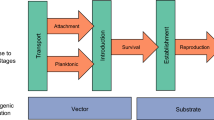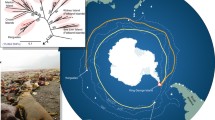Abstract
Historical and modern migrations and dispersal of most marine organisms (intertidal, benthic, meiofaunal, planktonic, nektonic, or neustonic) are classically interpreted in terms of their natural dispersal potential. Exceptions are introduced species, largely recognized since the 19th century, known to have been transported by human activities. However, humans were transporting species along coastlines and across oceans for millennia and centuries prior to the advent of the first biological surveys. Thus, the presumptive natural distributions of many species may be questioned. Reviewed here are some basic concepts about invasions of non-native species. Human activities move species isolated in time and space from other oceans or continents, and thus human-mediated transport does not simply speed up natural dispersal processes. Both past and modern-day invasions are often overlooked, leading to an underestimation of the scale of invasion diversity and impact. Because vectors, donor regions, and recipient regions change over time, invasions will continue along long-standing but un-managed corridors. The impact of most invasions has never been studied and, therefore, it is not possible to conclude that most invasions have no impact, nor is it generally possible to say that invasions have become ‘integrated’ into a community or ecosystem in ecological time. Finally, invasions in the ocean are not limited to harbours and ports, but are found in a wide variety of marine habitats, ranging from the open ocean continental shelf to exposed rocky shores. The existence of human-mediated vectors has created extraordinary challenges to our understanding and interpretation of the ecology, biogeography, evolutionary biology, and conservation biology of marine communities.
Access this chapter
Tax calculation will be finalised at checkout
Purchases are for personal use only
Preview
Unable to display preview. Download preview PDF.
Similar content being viewed by others
References
Berman, J., L. Harris, W. Lambert, M. Buttrick & M. Dufresne, 1992. Recent invasions of the Gulf of Maine: three contrasting ecological histories. Conserv. Biol. 6: 435–441.
Berrill, N. J., 1950. The Tunicata with an account of the British species. Ray Society, London. 354 pp.
Breton G., M. Faasse, P. Noël & T. Vincent, 2002. A new alien crab in Europe:Hemigrapsus sanguineus (Decapoda: Brachyura: Grapsidae). J. Crust. Biol. 22: 184–189.
Buttermore, R. E., E. Turner & M. G. Morrice, 1994. The introduced northern Pacific seastar Asterias amurensis in Tasmania. Mem. Queensland Museum 36: 21–25.
Carlton, J. T., 1979. Introduced invertebrates of San Francisco Bay. In Conomos, T. J. (ed.), San Francisco Bay: The Urbanized Estuary. American Association for the Advancement of Science, Pacific Division, San Francisco: 427–444.
Carlton, J. T., 1996a. Biological invasions and cryptogenic species. Ecology 77: 1653–1655.
Carlton, J. T., 1996b. Pattern, process, and prediction in marine invasion ecology. Biol. Conserv. 78: 97–106.
Carlton, J. T., 1999. The scale and ecological consequences of biological invasions in the world’s oceans. In Sandlund, O. T., P. Johan Schei & A. Viken (eds), Invasive Species and Biodiversity Management. Kluwer Academic Publishers, Dordrecht: 195–212.
Carlton, J. T., 2000a. Global change and biological invasions in the oceans. In Mooney, H. A. & R. J. Hobbs (eds), Invasive Species in a Changing World. Island Press, Covelo CA: 31–53.
Carlton, J. T., 2000b. Quo Vadimus Exotica Oceanica?: Marine Bioinvasion Ecology in the Twenty-First Century. In Pederson, J. (ed.), Marine Bioinvasions: Proceedings of the First National Conference. Massachusetts Institute of Technology, MIT Sea Grant College Program, MITSG 00–2, Cambridge, Massachusetts: 6–23.
Carlton, J. T., 2001. Introduced species in U.S. coastal waters: environmental impacts and management priorities. Pew Oceans Commission, Arlington, Virginia. 28 pp.
Carlton, J. T., 2002. Bioinvasion Ecology: Assessing Invasion Impact and Scale. In Leppäkoski, E., S. Gollasch & S. Olenin (eds), Invasive Aquatic Species of Europe. Distribution, Impacts, and Management, Kluwer Academic Publishers, Dordrecht, The Netherlands: 7–19.
Carlton, J. T. & J. A. Scanlon, 1985. Progression and dispersal of an introduced alga: Codium fragile ssp. tomentosoides (Chlorophyta) on the Atlantic coast of North America. Bot. mar. 28: 155–165.
Carlton, J. T., D. M. Reid & H. van Leeuwen, 1995. Shipping Study. The role of shipping in the introduction of non-indigenous aquatic organisms to the coastal waters of the United States (other than the Great Lakes) and an analysis of control options. The National Sea Grant College Program/Connecticut Sea Grant Project RIES-6. Department of Transportation, United States Coast Guard, Washington, D.C. and Groton, Connecticut. Report Number cg-D-11–95. Government Accession Number AD-A294809. xxviii + 213 pages and Appendices A-I (122 pages).
Gollasch, S., 1999. The Asian decapod Hemigrapsus penicillatus (de Haan, 1833) (Decapoda, Grapsidae) introduced in European waters, status quo and future perspective. Helgol. Meeresunters. 52: 359–366.
Griffiths, C. L., P. A. R. Hockey, C. Van Erkom Shurink & P. J. Le Roux, 1992. Marine invasive aliens on South African shores: implications for community structure and trophic functioning. S. Afr. J. mar. Sci. 12: 713–722.
Grosholz, E., 2002. Ecological and evolutionary consequences of coastal invasions. Trends Ecol. Evol. 17: 22–27.
Herbold, B. & P. B. Moyle, 1986. Introduced species and vacant niches. Am. Nat. 128: 751–760.
Hourani, G. F., 1995. Arab Seafaring. 2nd edn. Princeton University Press. 189 pp.
Kiener, A., 1972. Contribution a l’ecologie, la physiologie et l’ethologie de l’actinie Diadumene luciae (Verrill). Bull. Soc. Zool. France 96: 581–603.
King, M.-C. & A. G. Motulsky, 2002. Mapping human history. Science 298: 2342–2343.
Labaree, B. W., 1957. How the Greeks sailed into the Black Sea. Am. J. Archaeol 61: 29–33.
Leppäkoski, E., S. Gollasch & S. Olenin (eds), 2002. Invasive Aquatic Species of Europe. Distribution, Impacts, and Management, Kluwer Academic Publishers, Dordrecht, The Netherlands. 583 pp.
McIvor, L., C. A. Maggs, J. Provan & M. J.Stanhope. 2001. RbcL sequences reveal multiple cryptic introductions of the Japanese red alga Polysiphonia harveyi. Mol. Ecol. 10: 911–919.
Minchin, D. & S. Gollasch, 2002. Vectors — how exotics how get around. In Leppäkoski, E., S. Gollasch & S. Olenin (eds), Invasive Aquatic Species of Europe. Distribution, Impacts, and Management, Kluwer Academic Publishers, Dordrecht, The Netherlands: 183–192.
Oxford Atlas of the World, 2002. Oxford Atlas of the World. 10th edn. Oxford University Press: 304 pp.
Petersen, K. S.., K. L. Rasmussen, J. Heinemeler & N. Rud. 1992. Clams before Columbus? Nature 359: 679.
Ruiz, G. M., J. T. Carlton, E. D. Grosholz & A. H. Hines, 1997. Global invasions of marine and estuarine habitats by non-indigenous species: mechanisms, extent, and consequences. Am. Zool. 37: 621–632.
Ruiz, G. M., P. Fofonoff, A. H. Hines & E. D. Grosholz, 1999. Non-indigenous species as stressors in estuarine and marine communities: assessing invasion impacts and interactions. Limnol. Oceanogr. 44 (3, part 2): 950–972.
Ruiz, G. M., P. W. Fofonoff, J. T. Carlton, M. J. Wonham & A. H. Hines, 2000. Invasion of coastal marine communities in North America: apparent patterns, processes, and biases. Ann. Rev. Ecol. Syst. 31: 481–531.
Sandlund, O. T., R. J. Schei & A. Viken (eds), 1999. Invasive Species and Biodiversity Management. Kluwer Academic Publishers, Dordrecht. 431 pp.
Schneider, C. W. & R. B. Searles, 1991. Seaweeds of the Southeastern United States. Cape Hatteras to Cape Canaveral. Duke University Press, Durham and London. 554 pp.
Schwartz, M., 2002. Early evidence of reed boats from southeast Anatolia. Antiquity 76: 617–618.
Simberloff, D. & B. Von Holle, 1999. Positive interactions of nonindigenous species: invasional meltdown? Biol. Invasions 1: 21–32.
Southward, A. J., R. S. Burton, S. L. Coles, P. R. Dando, R. DeFelice, J. Hoover, P. E. Parnell, T. Yamaguchi & W. A. Newman, 1998. Invasion of Hawaiian shores by an Atlantic barnacle. Mar. Ecol. Prog. Ser. 165: 119–126.
Stachowicz, J. J., J. R. Terwin, R. B. Whitlatch & R. W. Osman, 2002. Linking climate change and biological invasions: ocean warming facilitates nonindigenous species Invasions. Proc. natl. Acad. Sci. 99: 15497–15500.
Strasser, M., 1999. Mya arenaria — an ancient invader of the North Sea coast. Helgol. Meeresunters. 52: 309–324.
Williamson, M., 1996. Biological invasions. Chapman & Hall, London. 244 pp.
Wonham, M. J., J. T. Carlton, G. M. Ruiz & L. D. Smith, 2000. Fish and ships: relating dispersal frequency to success in biological invasions. Mar. Biol. 136: 1111–1121.
Wyatt, T. & J. T. Carlton, 2002. Phytoplankton introductions in European coastal waters: why are so few invasions reported? pp. 41–46. In CIESM (Commission Internationale pour l’Exploration Scientifique de la mer Mediterranee) Workshop Monographs no. 20, 136 pp. Monaco.
Author information
Authors and Affiliations
Editor information
Editors and Affiliations
Rights and permissions
Copyright information
© 2003 Springer Science+Business Media Dordrecht
About this paper
Cite this paper
Carlton, J.T. (2003). Community assembly and historical biogeography in the North Atlantic Ocean: the potential role of human-mediated dispersal vectors. In: Jones, M.B., Ingólfsson, A., Ólafsson, E., Helgason, G.V., Gunnarsson, K., Svavarsson, J. (eds) Migrations and Dispersal of Marine Organisms. Developments in Hydrobiology, vol 174. Springer, Dordrecht. https://doi.org/10.1007/978-94-017-2276-6_1
Download citation
DOI: https://doi.org/10.1007/978-94-017-2276-6_1
Publisher Name: Springer, Dordrecht
Print ISBN: 978-90-481-6480-6
Online ISBN: 978-94-017-2276-6
eBook Packages: Springer Book Archive




